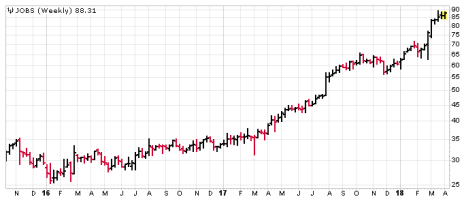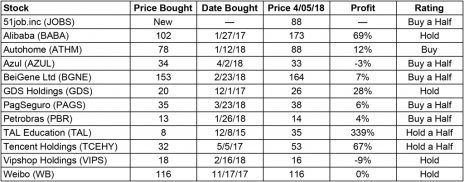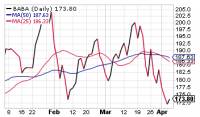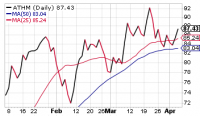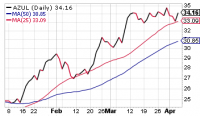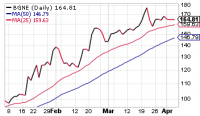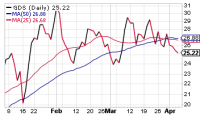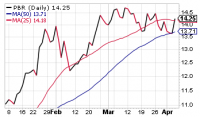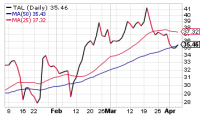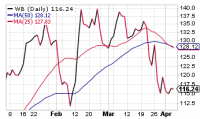The major market indexes have talked themselves off the ledge over the past couple of days, not exactly roaring back to health, but showing signs that buying interest isn’t completely gone. Headlines about a trade war between the U.S. and China have been a major disruptor, and I have some thoughts about that in this week’s commentary. I also have a Chinese stock that’s been ignoring the market’s wobbles and etching a great rally.
Cabot Emerging Markets Investor 656
[premium_html_toc post_id="147801"]
Cabot Emerging Markets Timer
The Emerging Markets Timer is our disciplined method for staying on the right side of the emerging markets. The Timer is bullish when the index is above the lower of its two moving averages and that moving average is trending up.
Our Emerging Markets Timer remains technically negative, though the overall trend continues to look more neutral than down. The iShares EM Fund (EEM) is currently sitting beneath both its 25-day and 50-day moving averages, hence the indicator’s negative reading, which is reason to be cautious. That said, EEM has held well above its February lows and is doing a lot more chopping than declining during the past two months.
While news of trade wars fill the air, it’s best to just keep focused on the market. Based on the evidence, we’re cautious, but are taking things mostly on a stock-by-stock basis, holding our resilient names while keeping tight leashes on losers and laggards.
Saber Rattling
The growth disciplines that Cabot has developed over the years are actually pretty simple: When markets are going up, you buy strong stocks with good stories, good numbers and good charts and stick with them until they lose momentum. When markets are correcting, you curtail new buying and tighten your mental stops. And you manage the stocks in your concentrated portfolio to avoid big losses.
We’ve even boiled it down to fewer words. Let winners run. Cut losers short. Stay in sync with the market.
As you may have noticed, there’s no real role for analysis of why markets are doing what they’re doing or anything in the way of predictions about what markets will do tomorrow.
But sometimes it’s hard to avoid thinking about what markets might be doing right now absent the economic tensions between the U.S. and China. The initial imposition by the Trump administration of tariffs on steel and aluminum imports was met by a relatively mild (about $3 billion) Chinese program of retaliatory levies on U.S. pork, wine and other exports.
The second round of U.S. tariff increases on April 3 targeted 1,333 Chinese products—from lithium batteries to semiconductors—to the tune of about $50 billion. The apparent target of the list is high-tech Chinese industries.
China responded with its own set of retaliatory tariffs, with a focus on U.S. soybean exports (the largest U.S. agricultural export to China), automobiles, planes, whiskey, cigars and cigarettes and chemicals. The soybean levies are clearly aimed at Midwestern U.S. farmers, the airplane tariffs are targeted straight at Boeing and the bourbon and tobacco industries are also in the crosshairs.
Of course none of the threatened trade sanctions has actually gone into effect. U.S. trade sanctions have to wait for a 60-day comment period and China has said it will wait for the tariffs to take effect before its retaliatory measures are imposed.
Thus, the “trade war” between the U.S. and China isn’t actually being fought yet, and all the talk about what trade sanctions will be imposed is just that—talk.
We won’t try to figure out who will win this war. Each side has both advantages and vulnerabilities, and there is the possibility of both genuine damage and genuine benefit to the economies of both countries. China wants to avoid unemployment and doesn’t need more debt, but has much firmer control over its citizens. The U.S. administration has a midterm election coming up, but the U.S. economy is probably more stable overall.
But investors in Chinese stocks, looking ahead by six months to a year, are definitely scrambling to sort out the possible winners and losers from this escalating (but still relatively minor) trade war. And, as always in the stock market, the first response to uncertainty is to reduce exposure by exiting higher-risk positions.
We are resolved to manage our portfolio on a stock-by-stock basis, but the threat of a trade war involving the world’s two largest economies is difficult to ignore. We will remain in a state of heightened vigilance.
But what we’re really focused on is the market itself and individual stocks—they will be your best guide to when the current trade tensions are easing, and will likely highlight which sectors and stocks are likely to lead the next upturn. Right now, the market is telling us to remain cautious—but not to stick our heads in the sand, either.
Featured Stock
Get A Job
51Job, Inc. (JOBS)
The touchy state of the relationship between China and the U.S. might seem like a pretty good reason to avoid a Chinese company as a new investment. But when we find a company that’s thriving and has a stock that’s completely ignoring the troubled state of the market, we have to pay attention.
51Job, the biggest online recruiting and employment site in China, is about as steady as you can get. The 371,000 unique employers who pay for the company’s services are constantly looking for new workers and new services. And with a combination of online and print recruitment services, 51Job offers online and on-campus recruitment, as well as business process outsourcing, training, executive searches and compensation consulting.
51Job was founded in 1998, when China was beginning its string of double-digit annual economic growth and factories were scrambling for workers. Recruiting was a relatively simple matter then, centered on leaflets and print ads. But as the country’s economy has matured, the needs of employers have changed, and 51Job, under the direction of founder Rick Yan, has grown into the task.
When the firm reported its Q4 and 2017 results on March 1, the results showed both a 10% expansion in the number of unique employers as customers and an 11% increase in the overall average revenue per user (ARPU) during the quarter. The ARPU growth is especially important because it shows that employers are signing up for multiple services. For example, the company’s online background check service, which is just one year old, has been bought by over 2,000 companies.
51Jobs’ 2017 results showed a 22% increase in revenue, a welcome double-digit rate after two years of single-digit growth (9% in 2015 and 7% in 2016). Q4 revenue growth came in at 33%. Also welcome was a 48% increase in earnings, and a record-high 37.5% after-tax profit margin, both of which reflected the higher ARPU numbers.
Analysts project 2018 earnings growth of 24% and 25% growth in 2019.
The other big attraction of 51Job is the chart. We like to see a stock that has a long base, and JOBS traded basically sideways from the beginning of 2011 through the middle of 2016. That long dormant period followed a rocket shot from 3 at the start of 2009 to 31 at the start of 2011, so some consolidation was to be expected. But almost six years of no progress is remarkable for a company that has been consistently profitable with growing revenue.
JOBS’ run higher really begins in 2017 with the stock at 34. A steady rise to 48 in July was followed by a high-volume boost in late July that pushed the stock to 55, with follow-on buying producing a run to 66 in October. A correction to 56 in December was followed by a rally to 72 as February began. JOBS dithered heading into its quarterly earnings announcement, then blasted off on March 2, reaching 77 in a day and following through to 89 on March 21.
One very attractive thing about JOBS is that it has been ignoring the weakness of the broad market, with a relative performance (RP) line that’s been rising since March 2017. JOBS is now trading around 88 after a two-week consolidation.
We’re taking the Emerging Markets Timer seriously, but we’re also taking JOBS’ outperformance of the broad market equally seriously. The best reconciliation we can do of the two competing signals is to start a new half position in JOBS and keep it on a short leash. A little patience may present you with an opportunity to get started on a dip of a couple of points. BUY A HALF.
51Job, Inc. (JOBS)
Building 3
No. 1387 Zhang Dong Rd.
Shanghai 201203, China
86 21 6160 1888
ir.51job.com
Model Portfolio
Invested 85% Cash 15%
Updates
Emerging market stocks remain in a sideways-to-down phase, with plenty of whippy action and diverging action among individual stocks. Overall, we’re preaching some caution, holding some cash and keeping new buys small. But we’re mostly continuing to take things on a stock-by-stock basis.
Tonight, we have just one ratings change (TAL to Hold a Half), but we also have a couple of stocks (namely VIPS and WB) with tight stops, so much further weakness would likely have us kicking one or both of those out to raise cash.
Alibaba (BABA) has slid sharply with the market during the past couple of weeks, even falling a bit below its uptrending 200-day line during yesterday’s tariff-induced morning selloff. That’s not a great sign, but the fact is the stock is still hovering in the range it’s occupied since October. Our patience isn’t limitless, but with shares finding support yesterday and today, and with the fundamental story remaining pristine (the company recently bought the rest of the shares it didn’t own of Ele.me, a big Chinese food delivery platform), we advise hanging on. HOLD.
While many major indexes are testing (or have fallen below) their 200-day moving average, Autohome (ATHM) is still hanging onto its 50-day line, which is a nice show of relative strength. We’d like to see some big-volume buying to tell us the sellers have left the building, but overall, the picture is encouraging. We’ll stay on Buy, but remember to keep new positions on the small side given the market. BUY.
We bought a half position in Azul S.A. (AZUL) last week, and the stock remains in good shape, just a point or so shy of all-time highs. We think this airline has huge potential as it adds new routes; the firm just announced a partnership with a French carrier to offer nonstop flights from Sao Paulo to Paris. BUY A HALF.
BeiGene (BGNE) is as speculative as you can get, but the stock remains very resilient—it hasn’t closed below its 25-day line since the market correction started in February! Of course, that solid run may attract some profit taking, but so far, it’s clear big investors aren’t eager to sell. If you don’t own any, we’re OK with a nibble here or on dips. BUY A HALF.
GDS Holdings (GDS) continues to slip gradually, but it’s still holding support. We want to give the stock every chance to hold up because we think it’s basically a chip shot that the company’s sales and cash flow will grow markedly in the quarters ahead as demand for its colocation and data center offerings booms. With our profit cushion (we bought around 20), we’ll stay on Hold, though a break into the low 20s would be a warning sign. HOLD.
PagSeguro (PAGS) dipped to its 25-day line in mid-March but catapulted off that line quickly, a very encouraging sign. PAGS is a newer issue and can swing around a bunch. But it trades on solid volume (about two million shares per day, on average), which is a sign some bigger investors are taking positions—not surprising given the firm’s exceptional growth prospects. Hold on if you own some, and if you don’t, try to sharpshoot a half position on a dip of a point or so. BUY A HALF.
Petrobras (PBR) shook out below its 50-day line yesterday morning before storming back today. Overall, the stock’s action during the past two months looks normal even as the market has thrown some curveballs. The company has just 15% of its oil output hedged this year, so if oil prices rise, much of that will fall right to the bottom line. BUY A HALF.
TAL Education (TAL) is being switched to Hold, as the stock’s action during the past couple of weeks is worrisome—after poking to new highs, shares have skidded straight down to their 50-day line. It’s not the worst chart in the world, and of course the education story in China remains terrific, but we’ll move to Hold and use a stop in the low 30s. HOLD A HALF.
Tencent Holdings (TCEHY) has pulled itself up by the bootstraps in recent days, holding support near 50 (a level the stock hasn’t breached since early December). Ideally, the stock’s up-and-down action since Thanksgiving represents the multi-month rest that the stock needed. That said, a break of support (the 200-day line is at 48 and rising) would be a red flag and make the past few months look like a top. Right here, we’re happy to hold, but we’re watching it closely. HOLD A HALF.
Vipshop (VIPS) is on a tight leash, as we have a small loss and the stock has dipped below its 50-day line. That said, in the context of its huge off-the-bottom move starting last December (from 8 to 19!), we think the recent action is normal and the stock’s major turnaround is still intact. A dip toward 15 would probably have us cutting the loss, but right here, hang on. HOLD.
Weibo (WB) is in a similar boat as VIPS—it’s pulled back recently but has held some key support (its 200-day line) and begun to bounce. We’re well aware that WB has enjoyed a monstrous advance since its first breakout in early 2016, so it could need a prolonged correction and consolidation. That said, we also know that the growth story is second to none, with earnings growth projected at 56% this year and 44% in 2019 (and analysts are usually low on their estimates). Bottom line, we’ll just let the stock tell its own story—we’re holding here, but a drop into the high 100s would be a red flag. HOLD.
[premium_html_footer]
Send questions or comments to paul@cabotwealth.com.
Cabot Emerging Markets Investor • 176 North Street, Salem, MA 01970 • www.cabotwealth.com
All Cabot Emerging Markets Investor buy and sell recommendations are made in issues or updates and posted on the Cabot subscribers’ website. Sell recommendations may also be sent to subscribers as special alerts via email. To calculate the performance of the hypothetical portfolio, Cabot “buys” and “sells” at the midpoint of the high and low prices of the stock on the day following the recommendation. Cabot’s policy is to sell any stock that shows a loss of 20% in a bull market (15% in a bear market) from our original buy price, calculated using the current closing (not intra-day) price. Subscribers should apply loss limits based on their own personal purchase prices.
THE NEXT CABOT EMERGING MARKETS INVESTOR ISSUE IS SCHEDULED FOR April 19, 2018
We appreciate your feedback on this issue. Follow the link below to complete our subscriber satisfaction survey: Go to: www.surveymonkey.com/chinasurvey
Cabot Emerging Markets Investor is published by Cabot Wealth Network, an independent publisher of investment advice since 1970. Neither Cabot Wealth Network, nor our employees, are compensated in any way by the companies whose stocks we recommend. Sources of information are believed to be reliable, but they are in no way guaranteed to be complete or without error. Recommendations, opinions or suggestions are given with the understanding that subscribers acting on information assume all risks involved. © Cabot Wealth Network 2017. Copying and/or electronic transmission of this report is a violation of the copyright law. For the protection of our subscribers, if copyright laws are violated, the subscription will be terminated. To subscribe or for information on our privacy policy, visit www.cabotwealth.com, write to support@cabotwealth.com or call 978-745-5532.
[/premium_html_footer]



